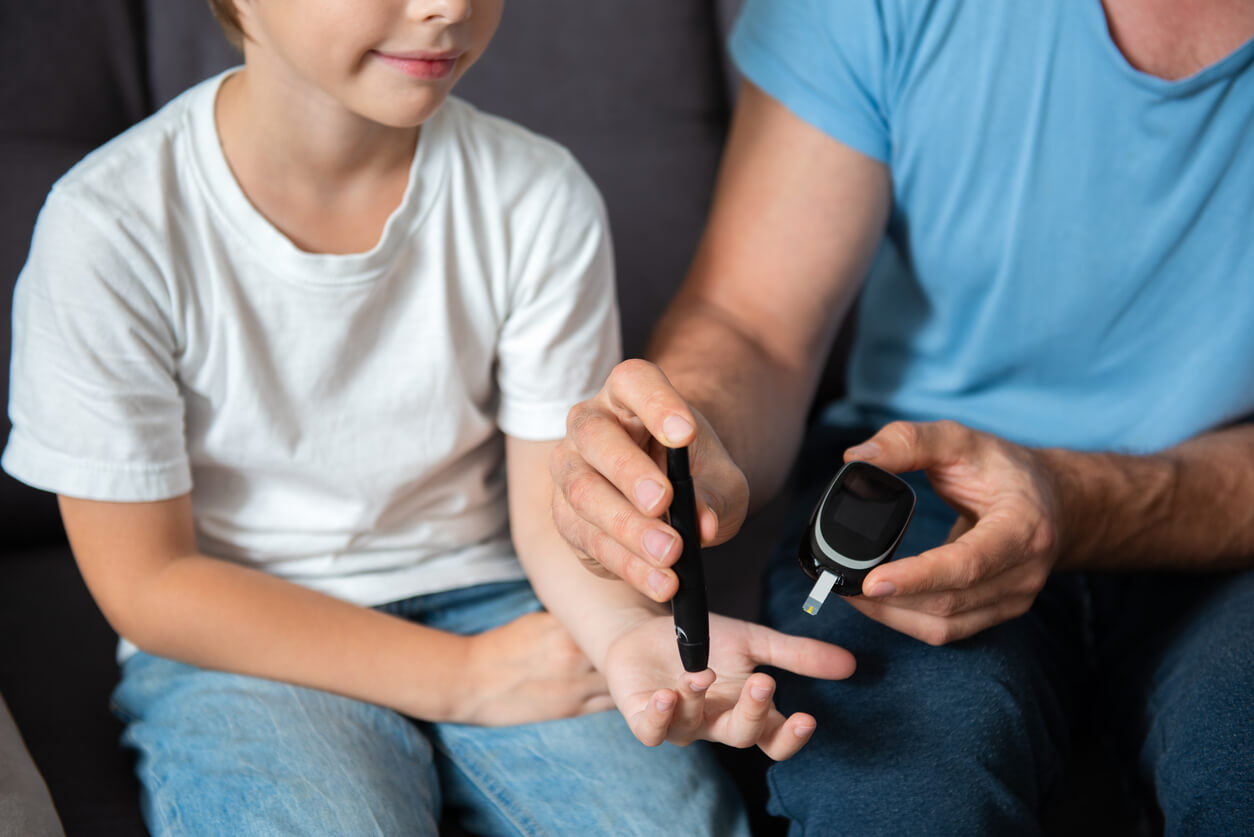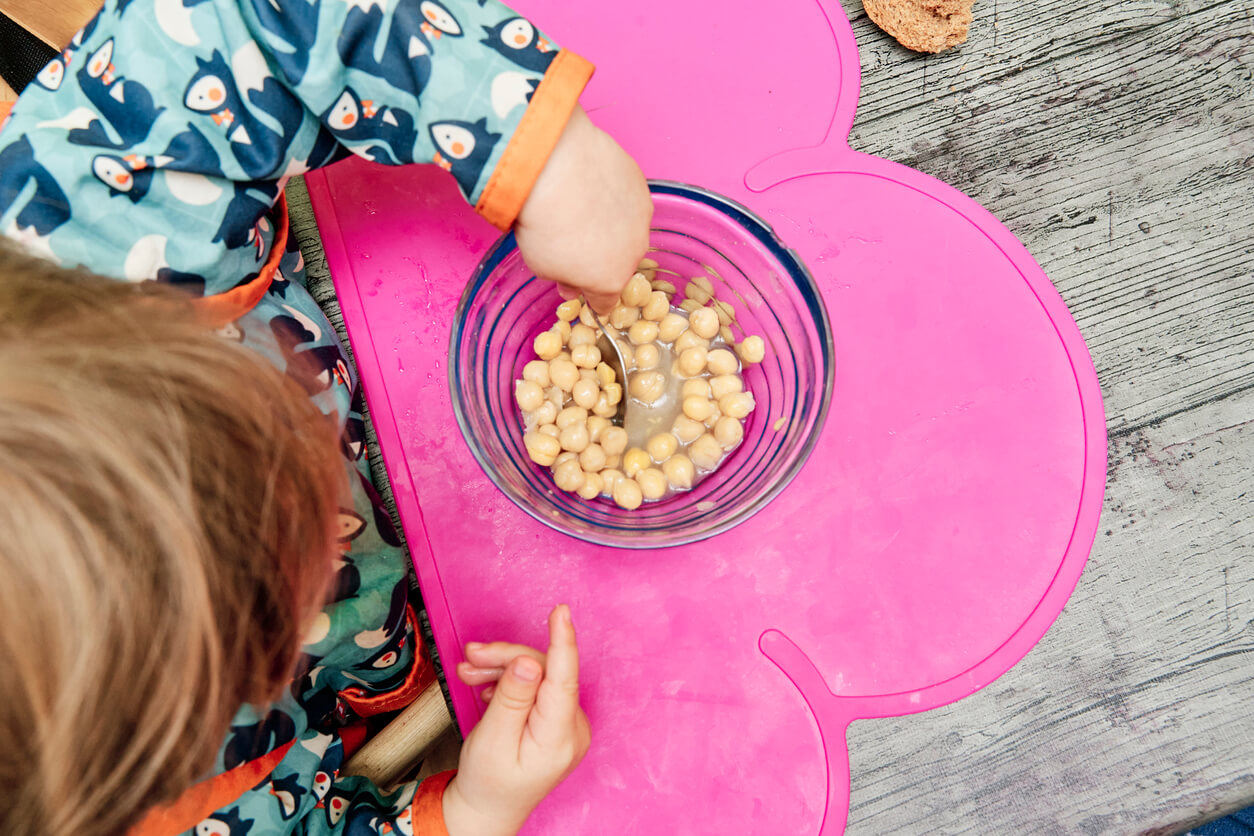Healthy Eating for Children with Diabetes

If anyone thinks there’s a difference between the nutritional needs of children with diabetes and children without diabetes, they’re wrong. The only difference is that children with diabetes must learn to pay attention to what they eat and when they eat it. It’s about being more aware of their own nutrition.
Consulting with their doctor, controlling their meal schedule, and learning to count carbohydrates are some tips that will help control diabetes. Keep reading for more details.
What is diabetes?
Diabetes is a metabolic disorder that prevents the body from using carbohydrates or sugars contained in food properly. The most frequent in children is type 1 diabetes, which appears before 15 years of age and requires the administration of insulin. Type 2 diabetes appears more in adulthood, but nowadays, it’s associated with high rates of obesity in children and doesn’t require insulin.
How to assure healthy eating in children with diabetes?
The energy and nutrient needs of children with diabetes are no different from those of the rest of the child population. According to the HealthyChildren organization, they need to be helped to take responsibility for their diabetes, while becoming more independent. The main goal of healthy eating is to keep blood sugar and lipids under control. To do this, the meal plan should be as follows:
- Sufficient: So that it provides all the energy the child needs at each stage of growth without causing the child to become overweight or underweight.
- Balanced: Energy should be provided by the different nutrients in the recommended proportions.
- Varied: The diversity of nutrients must come from a wide range of foods and be adapted to the pharmacological treatment (insulin).
- Satisfactory: It must satisfy all requirements in the medium and long term and improve the quality of life.

How is energy distributed throughout the day?
50 to 60 percent of all energy is required to come from carbohydrates. For example, for an 1800-calorie diet, carbohydrates will account for 225 grams. Protein will contribute 12 to 15 percent, which is equivalent to 67 grams per day. Fats are estimated at 30 to 35 percent or 70 grams per day.
Carbohydrates
Carbohydrates are the macronutrients that directly affect the amount of sugar in the blood. These can be either starches or simple starches. In the end, both are transformed into glucose to be absorbed. There are foods that have carbohydrates that are rapidly absorbed and others that are slowly absorbed. The speed at which a carbohydrate is absorbed is called the glycemic index (GI).
Factors such as type of cooking, consistency, the presence of fiber or fat, and protein increase or decrease the absorption of sugar. A healthy diet for children with diabetes includes foods with a low glycemic index value of less than 55. Here are some examples of foods considered by the Diabetes Foundation:
- Whole or skim milk and dairy products
- Brown rice, oatmeal, barley, rye, and high-fiber breakfast cereals
- Rice noodles, sugar-free crackers, and boiled quinoa
- Legumes, such as chickpeas, beans, and peas
- Fruits: Apples, peaches, blackberries, pears, nectarines, oranges, and quinces, as well as a wide variety of vegetables
- Dried fruits and nuts
Proteins
Fat-free animal proteins are suggested, such as egg whites, skinless chicken, rabbit, turkey, and fish. In addition, red meat should be limited. As for vegetables, legumes, and combined cereals should be selected to increase the quality of amino acids, as well as nuts.
Fats
The healthiest fats to use in the diet of children with diabetes are omega-3, which are found in nuts and fatty fish such as sardines, salmon, palometa, or tuna, among others. For its part, olive oil should predominate among these types of products.
Combine and balance the diet
Low GI carbohydrates can be combined with each other and with protein foods and sources of healthy fats. This will allow a slower digestion process so that the sugars are gradually absorbed in the intestine. In addition, about 25 grams of fiber per day is also recommended to increase satiety and further reduce the absorption of nutrients. Vegetables, fruits, cereals, and legumes provide both soluble and insoluble fiber.
Different cooking techniques should be applied to the preparations. In addition, the meal schedule should be adapted to the pharmacological treatment and to the school, social, and family routine.
Read also: 4 Games to Work on Healthy Eating

Other tips for maintaining a healthy diet
In addition to a correct selection and distribution of macronutrients in the diet of children with diabetes, the following is also required:
Frequent visits to the doctor
The child’s pediatrician and nutritionist are the health experts who will monitor the evolution of the child and make the necessary adjustments to their meal plan. Emphasis will be placed on carbohydrate intake, sugar controls, and appropriate insulin doses.
Learn to count carbohydrates
The child and family members should practice healthy eating and be aware of the importance of counting carbohydrates at each meal. The amount to be eaten will determine the insulin dose. In addition, by learning this, they’ll be able to indulge in some cravings. For example, on a birthday, they can partake of certain foods, as long as they know the insulin dose for the number of carbohydrates they eat.
Read food labels
Food labels provide good information that will help with blood sugar control. They show the amount of carbohydrates per serving so you can multiply by the number of servings to be eaten. They also show the type and amount of fat, as well as the calories in the food. Other nutrients of interest that you can find there are proteins.
Download an application to count or calculate calories or carbohydrates
There are many applications with portion sizes and food lists. These can be used to calculate the number of carbohydrates to be consumed per preparation, both at home and away from home.
Record the food your child eats
To keep track of your child’s diet, you should record what your child eats, the time of day, the number of carbohydrates, and their blood sugar level. If possible, buy a scale to weigh each preparation. With this information, both the doctor and the nutritionist will decide if the diet needs to be adjusted.
Serve new, healthy, and delicious recipes
You can consult with professionals to give variety to the meals and snacks you offer your child. It’s important that they don’t feel that they’re on a special diet because of their metabolic disorder.
A proper diet is key
A child with diabetes doesn’t need a special diet. If it’s healthy and nutritious like that of other children, that’s enough. You should always combine low glycemic carbohydrates with lean proteins and healthy fats. Foods that are sources of fiber should accompany each preparation.
Always watch their meal times, count carbohydrates, and adjust insulin dosage. These three rules must never be broken. Remember that your pediatrician and nutritionist are your allies.
If anyone thinks there’s a difference between the nutritional needs of children with diabetes and children without diabetes, they’re wrong. The only difference is that children with diabetes must learn to pay attention to what they eat and when they eat it. It’s about being more aware of their own nutrition.
Consulting with their doctor, controlling their meal schedule, and learning to count carbohydrates are some tips that will help control diabetes. Keep reading for more details.
What is diabetes?
Diabetes is a metabolic disorder that prevents the body from using carbohydrates or sugars contained in food properly. The most frequent in children is type 1 diabetes, which appears before 15 years of age and requires the administration of insulin. Type 2 diabetes appears more in adulthood, but nowadays, it’s associated with high rates of obesity in children and doesn’t require insulin.
How to assure healthy eating in children with diabetes?
The energy and nutrient needs of children with diabetes are no different from those of the rest of the child population. According to the HealthyChildren organization, they need to be helped to take responsibility for their diabetes, while becoming more independent. The main goal of healthy eating is to keep blood sugar and lipids under control. To do this, the meal plan should be as follows:
- Sufficient: So that it provides all the energy the child needs at each stage of growth without causing the child to become overweight or underweight.
- Balanced: Energy should be provided by the different nutrients in the recommended proportions.
- Varied: The diversity of nutrients must come from a wide range of foods and be adapted to the pharmacological treatment (insulin).
- Satisfactory: It must satisfy all requirements in the medium and long term and improve the quality of life.

How is energy distributed throughout the day?
50 to 60 percent of all energy is required to come from carbohydrates. For example, for an 1800-calorie diet, carbohydrates will account for 225 grams. Protein will contribute 12 to 15 percent, which is equivalent to 67 grams per day. Fats are estimated at 30 to 35 percent or 70 grams per day.
Carbohydrates
Carbohydrates are the macronutrients that directly affect the amount of sugar in the blood. These can be either starches or simple starches. In the end, both are transformed into glucose to be absorbed. There are foods that have carbohydrates that are rapidly absorbed and others that are slowly absorbed. The speed at which a carbohydrate is absorbed is called the glycemic index (GI).
Factors such as type of cooking, consistency, the presence of fiber or fat, and protein increase or decrease the absorption of sugar. A healthy diet for children with diabetes includes foods with a low glycemic index value of less than 55. Here are some examples of foods considered by the Diabetes Foundation:
- Whole or skim milk and dairy products
- Brown rice, oatmeal, barley, rye, and high-fiber breakfast cereals
- Rice noodles, sugar-free crackers, and boiled quinoa
- Legumes, such as chickpeas, beans, and peas
- Fruits: Apples, peaches, blackberries, pears, nectarines, oranges, and quinces, as well as a wide variety of vegetables
- Dried fruits and nuts
Proteins
Fat-free animal proteins are suggested, such as egg whites, skinless chicken, rabbit, turkey, and fish. In addition, red meat should be limited. As for vegetables, legumes, and combined cereals should be selected to increase the quality of amino acids, as well as nuts.
Fats
The healthiest fats to use in the diet of children with diabetes are omega-3, which are found in nuts and fatty fish such as sardines, salmon, palometa, or tuna, among others. For its part, olive oil should predominate among these types of products.
Combine and balance the diet
Low GI carbohydrates can be combined with each other and with protein foods and sources of healthy fats. This will allow a slower digestion process so that the sugars are gradually absorbed in the intestine. In addition, about 25 grams of fiber per day is also recommended to increase satiety and further reduce the absorption of nutrients. Vegetables, fruits, cereals, and legumes provide both soluble and insoluble fiber.
Different cooking techniques should be applied to the preparations. In addition, the meal schedule should be adapted to the pharmacological treatment and to the school, social, and family routine.
Read also: 4 Games to Work on Healthy Eating

Other tips for maintaining a healthy diet
In addition to a correct selection and distribution of macronutrients in the diet of children with diabetes, the following is also required:
Frequent visits to the doctor
The child’s pediatrician and nutritionist are the health experts who will monitor the evolution of the child and make the necessary adjustments to their meal plan. Emphasis will be placed on carbohydrate intake, sugar controls, and appropriate insulin doses.
Learn to count carbohydrates
The child and family members should practice healthy eating and be aware of the importance of counting carbohydrates at each meal. The amount to be eaten will determine the insulin dose. In addition, by learning this, they’ll be able to indulge in some cravings. For example, on a birthday, they can partake of certain foods, as long as they know the insulin dose for the number of carbohydrates they eat.
Read food labels
Food labels provide good information that will help with blood sugar control. They show the amount of carbohydrates per serving so you can multiply by the number of servings to be eaten. They also show the type and amount of fat, as well as the calories in the food. Other nutrients of interest that you can find there are proteins.
Download an application to count or calculate calories or carbohydrates
There are many applications with portion sizes and food lists. These can be used to calculate the number of carbohydrates to be consumed per preparation, both at home and away from home.
Record the food your child eats
To keep track of your child’s diet, you should record what your child eats, the time of day, the number of carbohydrates, and their blood sugar level. If possible, buy a scale to weigh each preparation. With this information, both the doctor and the nutritionist will decide if the diet needs to be adjusted.
Serve new, healthy, and delicious recipes
You can consult with professionals to give variety to the meals and snacks you offer your child. It’s important that they don’t feel that they’re on a special diet because of their metabolic disorder.
A proper diet is key
A child with diabetes doesn’t need a special diet. If it’s healthy and nutritious like that of other children, that’s enough. You should always combine low glycemic carbohydrates with lean proteins and healthy fats. Foods that are sources of fiber should accompany each preparation.
Always watch their meal times, count carbohydrates, and adjust insulin dosage. These three rules must never be broken. Remember that your pediatrician and nutritionist are your allies.
All cited sources were thoroughly reviewed by our team to ensure their quality, reliability, currency, and validity. The bibliography of this article was considered reliable and of academic or scientific accuracy.
- Asociación Española de Dietistas Nutricionistas (AEDN). Alimentación y diabetes infantil. 114 p.p. Disponible en: https://www.solucionesparaladiabetes.com/biblioteca/varios/Alimentacion-diabetes-infantil_Menarini-Diagnostics.pdf
- Fundación de diabetes. La alimentación de tus niños con diabetes. Adaptación de “la alimentación de tus niños” AESAN (2005). Disponible en: https://www.fundaciondiabetes.org/upload/publicaciones_ficheros/36/alimentacion_ninos_diabetes08.pdf
- Fundación para la Diabetes. Tabla de raciones. Hidratos de carbono. Disponible en: https://www.fundaciondiabetes.org/upload/publicaciones_ficheros/71/TABLAHC.pdf
- Healthychildren.org. Diabetes infantil. Disponible en: https://www.healthychildren.org/Spanish/health-issues/conditions/chronic/Paginas/Diabetes.aspx
This text is provided for informational purposes only and does not replace consultation with a professional. If in doubt, consult your specialist.








